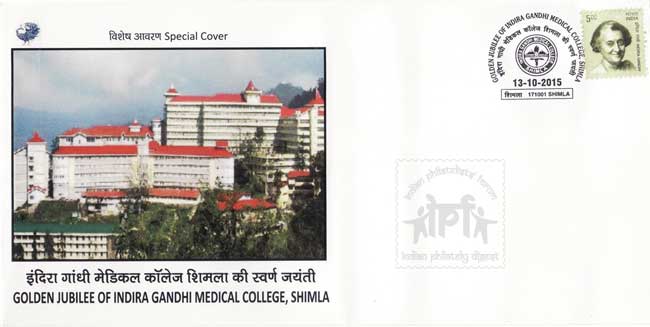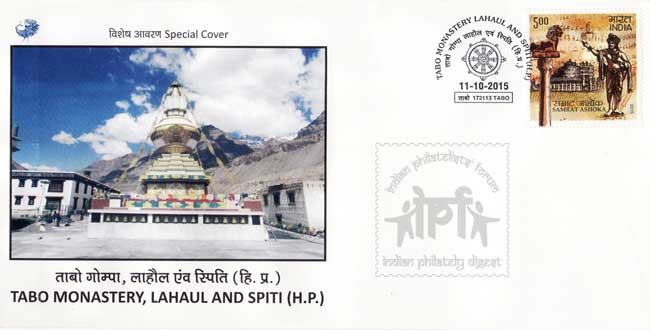- April 2018
- March 2018
- February 2018
- January 2018
- December 2017
- November 2017
- October 2017
- September 2017
- August 2017
- July 2017
- June 2017
- May 2017
- April 2017
- March 2017
- February 2017
- January 2017
- 2017
- 2016
- 2015
- 2014
- 2013
News : October 2015
Special Cover on Golden Jubilee Year of MGM School, Bhilai – 29th October 2015.
Mar Gregorios Memorial Senior Secondary School, christened as M.G.M. by people of Bhilai, was established in 1965 by the members of the M.G.O. Cathedral. It is one of the premier and first co-educational private schools in Bhilai Township. The school is founded in the name of the canonized Saint of the Malankara Orthodox Syrian Church, Late Mar Gregorios of Parumala, Kerala, who pioneered the cause of education in the rural areas of Kerala. The school satisfies the need of all the people in and around Bhilai Township to educate their children with its secular approach, in a holistic way. The school is affiliated to C.B.S.E. New Delhi.
A Special Cover was released to mark Golden Jubilee Year of MGM School on 29th October 2015 at Bhilai.
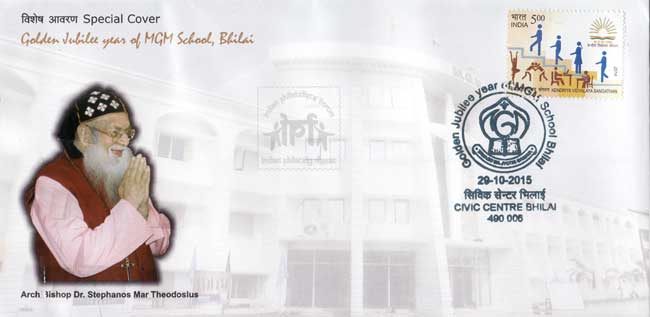
Courtesy: Sreejesh Krishnan, Thiruvananthapuram
Army Postal Cover on Bicentenary of The First Gorkha Rifles – 29th October 2015.
The First Gorkha Rifles is a Gorkha infantry regiment of the Indian Army comprising Gurkha soldiers of Nepalese origin. The Gorkha Rifles of the Indian Army is known for their Khukris, their ‘Aayo Gorkhali’ battle cry and their motto being 'Kayar Hunu Bhanda Marnu Ramro' (Better to die than live like a coward). The Gorkhas were first recruited by the East India Company and later fought under the British in several battles including World War I and II and continued in the Indian Army after Independence. The first regiment of Gorkhas was raised by Sir Robert Colquhuon on 24th April, 1815 in Uttaranchal with men from Gorkhas, Kumaon and Garhwal regions. Two battalions, 1/1 GR and 1/3 GR, were raised. There are roughly around 30,000 Gorkhas currently serving in the Indian Army’s seven Gorkha Rifles or regiments (1st, 3rd, 4th, 5th, 8th, 9th and 11th), each of which has five to six battalions (around 800 soldiers each). The Gorkhas are highly decorated having earned 117 gallantry and distinguished awards since Independence including an Ashoka and Kirti Chakra, two Shaurya Chakras and a Padma Bhushan among others. India's first Field Marshal Sam Manekshaw belongs to this regiment as does the current Army Chief General Dalbir Singh.
The First Gorkha Rifles completed 200 years of their raising and to mark the Bicentenary of The First Gorkha Rifles Army Postal Service released an Army Postal Cover on 29th October 2015 at 14 GTC Subathu, Himachal Pradesh.


Courtesy: Shri Mukesh Kapila
Commemorative Stamps on Third Africa-India Forum Summit (AIFS-III) – 29th October 2015.
India and Africa have a historic relationship and this has grown into a sustainable partnership. India hosted the Third Africa-India Forum Summit (AIFS-III) at Indira Gandhi National Stadium Complex, New Delhi from 26th to 29th October 2015. The summit was attended by representatives of 54 countries, including 41 heads of State and governments of African countries. India and a resurgent Africa have a vision of a close partnership. India-Africa partnership is anchored in the principles of equality, mutual respect and mutual benefit. The third edition of IAFS summit enabled consultations at the highest political level between the heads of government of 54 nations across Africa and the Indian government to give a new thrust to age-old partnership.
To commemorate the Summit, Prime Minister of India, Shri Narendra Modi, President of Zimbabwe and AU Chairperson, Rober Mugabe and other dignitaries released a Set of Six commemorative stamps and Miniature Sheets on Third Africa-India Forum Summit (AIFS-III) at New Delhi on 29th October, 2015. Four stamps are in denomination of Rs. 5 and two stamps are in denomination of Rs. 25 each. Stamps depict Indian and African Rhinoceros, Black Buck, Thomson's gazelle, Indian Lion and African Lion.
Two Miniature Sheets having same stamp designs but one with normal stamps and another with innovative technologies is having Hot-Foil stamping and embossing have been issued. In case of innovative miniature sheet, the Indian Rhino, African Rhino and Black Buck are Hot-foil stamped with Gun metal foil, the two Lions are Gold foiled and the Thomson Gazelle with Copper foil. After foiling, all the designs are embossed. Normal Miniature Sheet is priced at Rs. 70 where as innovative Miniature Sheet is priced at Rs. 200. Innovative Miniature Sheet with multicolour jacket is being sold at Rs. 300 at ePost Office and Shopclues.com



The Indian rhinoceros (Rhinoceros unicornis), also called the greater one-horned rhinoceros and great Indian rhinoceros, is a rhinoceros native to the Indian subcontinent. Creating folds that look like armor, the skin of the Indian rhinoceros is a brownish-gray hue with raised wart-like bumps on the neck, shoulders, and legs. Its single horn distinguishes the Indian rhinoceros from its African counterparts, who all have two horns. Historically, the Indian rhinoceros once existed across the entire northern part of the Indian subcontinent, along the Indus, Ganges and Brahmaputra River basins, from Pakistan to the Indian-Burmese border, including parts of Nepal, Bangladesh and Bhutan. Currently, the Indian rhinoceros exists in a few small subpopulations in the Nepal and India.
There are two species of African rhinoceros – the white and the black. Despite their names, both are the same dark grey-brown colour. It’s thought that the name ‘white rhino’ is a misinterpretation of the Afrikaans word ‘wyd’, referring to its square upper lip. Black rhinos have hooked lips. White rhinos mainly live in South Africa, but they have also been reintroduced to Botswana, Namibia, Swaziland, and Zimbabwe. Southern white rhinos have been introduced to Kenya, Zambia, and Cote d’Ivoire. The majority of the black rhino population—98%—is concentrated in four countries: South Africa, Namibia, Zimbabwe, and Kenya. South Africa houses 40% of the total black rhino population. There are some black rhinos in the region spread between Cameroon and Kenya.
The Blackbuck (Antilope cervicapra), also called Kala Hiran, Sasin, Iralai Maan or Krishna Jinka is the only representative of genus antilope found in India. It is one of the most graceful animals and used to be seen in thousands at the beginning of this century all throughout the plains of India except the Western coast. Due to extensive poaching and habitat loss, blackbuck populations have been reduced drastically. Now they can be seen in a few protected areas like the Guindy National park and IITM campus, Point Calimere and Vellanadu Sanctuaries in Tamil Nadu and Rollapadu (Andhra Pradesh), Velavadar (Gujarat) and Chilka (Orissa) other than few parts of Rajasthan and Haryana.
Thomson’s gazelles (Eudorcas thomsonii), named after researcher Joseph Thomson, sometimes referred to as a "tommie" have light-brown coats with darks stripes running down their sides, a white patch on their rumps extending underneath the tail, and ridged horns that curve backward. Females may have shorter, smoother, and slimmer horns than males or none at all. Grant’s gazelles are sometimes confused with Thomson’s. However, Thomson’s is distinguished from Grant’s by its smaller size and the white patch on its rump. On Grant’s gazelles, the patch always extends above the tail. It is considered by some to be a subspecies of the red-fronted gazelle and was formerly considered a member of the genus Gazella within the subgenus Eudorcas, before Eudorcas was elevated to genus status. Thomson’s gazelles prefer savannas and grassland habitats, particularly in the Serengeti region of Kenya and Tanzania.
The Asiatic lion (Panthera leo persica), also known as the Indian lion or Persian lion, is a lion subspecies that exists as a single population in India's Gujarat state. The Asiatic lion is one of five big cat species found in India, apart from Bengal tiger, Indian leopard, snow leopard and clouded leopard. It formerly occurred in Persia, Palestine, Mesopotamia, Baluchistan, from Sindh in the west to Bengal in the east, and from Rampur and Rohilkund in the north to Nerbudda in the south. It differs from the African lion by less inflated auditory bullae, a larger tail tuft and a less developed mane.
The lion (Panthera leo) is one of the five big cats in the genus Panthera and a member of the family Felidae. The commonly used term African lion collectively denotes the several subspecies found in Africa. African lions are the biggest of the African carnivores. Color is tawny to sandy brown. The long tail has a distinctive black tuft at the tip. The adult males have manes which vary in color from tawny to black. Though lions used to live in most parts of Africa, they are now found only in the south Sahara desert and in parts of southern and eastern Africa.
Special Cover on World PolioPlus Day – 23rd October 2015.
Rotary International is the volunteer arm of a global partnership dedicated to eradicating polio. In 1985 Rotary volunteers around the world embraced the fight against polio and 'POLIOPLUS' was born. The PolioPlus programme is the most ambitious programme in Rotary's history. The initiative is an aggressive public-private partnership to assist International Health Agencies and Governments in eradicating polio from the world. In India, Rotary International established separate committees in 1988, named the India National PolioPlus Committee (INPPC), to exclusively steer Rotary's polio eradication programme in India.
A Special Cover on the eve of World Polio Day was released on 23rd October 2015 by Smt. Rajashree Birla, Director of Aditya Birla Group in presence of Shri Hamid Patel, Senior Superintendent of Post – Mumbai South and other dignitaries of Rotary Internation at the event organized at the Rotary Service Centre, Juhu, Mumbai by India National PolioPlus Committee of Rotary International and Rotary Club of Bombay West to celebrate ‘Four Years of Polio-free India’ (Special Cover approval no. MH/31/2015).
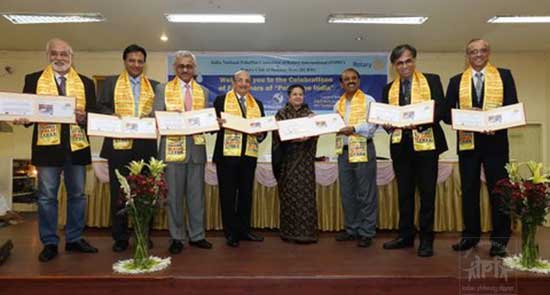
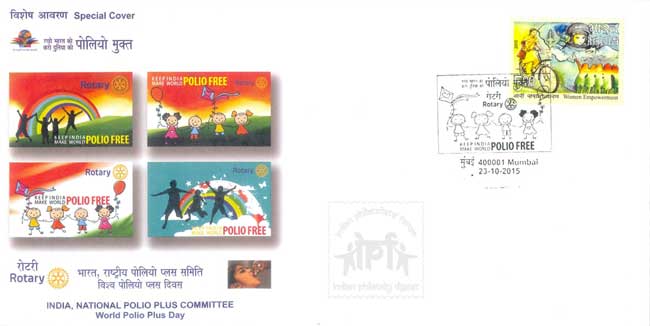
Cover Courtesy: Jigar Desai, Mumbai
Special Cover on Pride of Kullu Dussehra 2015 - 26th October 2015.
Kullu Dussehra is a centuries-old festival and celebrations begin on “Vijaya Dashami“, the day when the festivities end in rest of the country. Pride of Kullu, a mega ‘Nati’ event, is the main attraction of Dussehra. Nati dance is a local folk dance of Kullu district of Himachal Pradesh and depicts ras lila or dances concerning Hindu God Krishna and Gopis and the entertaining plays of Chandravali. Dancers join their hands and make movement accordingly with the music and rhythm. However, there are thirteen styles.
Last year on 7th October 2014, during Kullu Dussehra over 8,500 artists performed historic ‘Nati’ dance at the Kullu Dussehra festivities and entered the Limca Book of Records. The event was named as PRIDE OF KULLU based on theme BETI HAI ANMOL. After being featured in Limca Book in 2014, this year during Dussehra festival on 26th October 2015, the grand event was organized to spread awareness about female foeticide and the ‘Beti hai Anmol’ campaign of the Himachal Pradesh Government. More than 14,000 participants dressed in colorful folk attire participated in the mega event at Dhalpur grounds to make the Guinness Book of World Records and to showcase rich cultural heritage of Kullu.
Two special covers were released on the occasion to mark ‘Pride of Kullu – Dussehra – Beti Hai Anmol’ on 26th October 2015 at Kullu (Special Cover approval nos. HP/06/2015 and HP/07/2015).
The Nati folk dance of Kullu district has made a world record by entering the Guinness Book of World Records as the largest folk dance in the world on 11th January, 2016. After their full satisfaction the officials of Guinness Book of World Records, registered the Pride of Kullu Nati as the largest folk dance in terms of participants’ number.
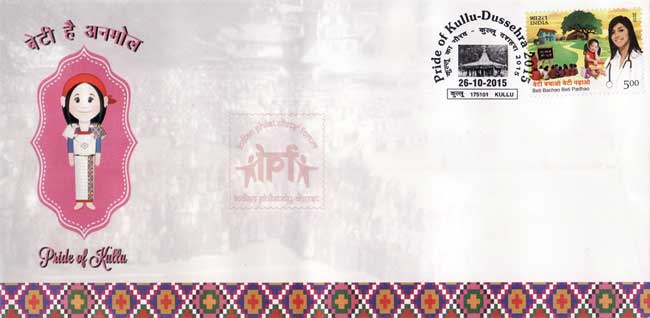
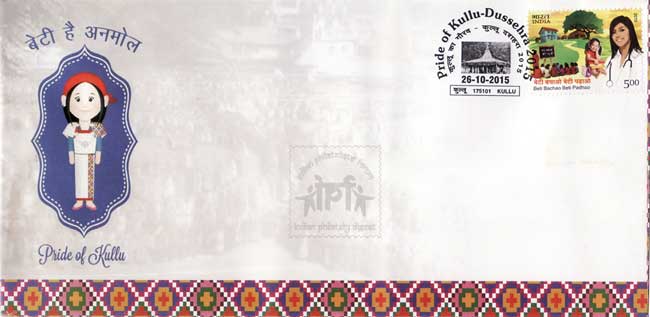
Courtesy: Sreejesh Krishnan, Thiruvananthapuram
Special Cover on Quasquicentenary of Kandathil Kudumbayogam – 22nd October 2015.
Inspired by Mathulla Mappillai, the illustrious Kandathil Varghese Mappillai established the Kandathil Kudumbayogam. It was started as a joint stock company in 1892 and is one of the foremost to be registered as a limited company. Punaloor Paper Mills Ltd. being the first, second being Malayala Manorama Co. Ltd. and our Kudumbayoga Company stands third in the series. The Kudumbayoga Company was liquidated in 1968 and the "Kandathil Kudumbayogam Association" was formed as a registered charitable trust. The "Kandathil Kudumbaogam festival" and "All Souls` Day" are being held under the auspices of this association every year. The aim of the Kudumbayogam is to maintain solidarity and unity among family members and to instill in them a taste in fine arts, cultural activities. Religious, moral and educational development of family members is also envisaged. The motto of Kandathil Kudumbayogam is FAITH, HOPE AND LOVE.
The Quasquicentenary of the Kandathil Kudumbhayogam was celebrated on 22nd October, 2015 at Kottayam. On this historic occasion, Nobel Laureate, Shri Kailash Satyrarthi was the Chief Guest. A Special Cover was released to mark Quasquicentenary of Kandathil Kudumbayogam on 22nd October 2015 at Kottayam (Special Cover approval no. KL-11/2015).
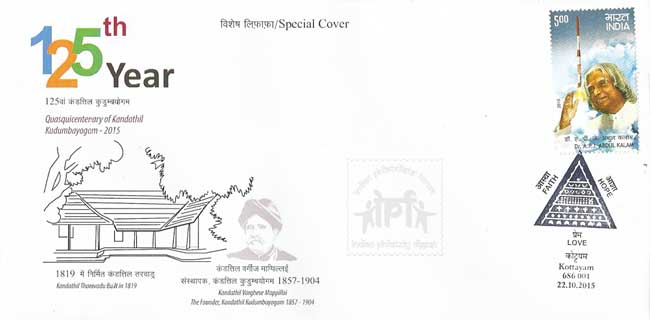
Courtesy: Sreejesh Krishnan, Thiruvananthapuram
Commemorative Stamp on Border Security Force – 21st October 2015.
 The Border Security Force (BSF) is the primary Border Guarding police force of India. It is one of the five Central Armed Police Forces of the Union of India. Till 1965 India’s borders with Pakistan were manned by the State Armed Police Battalion. Pakistan attacked Sardar Post, Chhar Bet and Beria Bet on 9 April, 1965 in Kutch. This exposed the inadequacy of the State Armed Police to cope with armed aggression due to which the Government of India felt the need for a specialized centrally controlled Border Security Force, which would be armed and trained to man the International Border with Pakistan. As a result of the recommendations of the Committee of Secretaries, the Border Security Force came into existence on 1st December 1965, and Shri K. F. Rustamji was the first chief and founding father. The BSF is a Central Armed Police Force charged with guarding India's land border during peace time and preventing transnational crime. It is a Union Government Agency under the administrative control of Ministry of Home Affairs. The BSF has its own cadre of officers but its head, designated as a Director-General (DG), since its raising has been an officer from the Indian Police Service. It is an Armed Force of the Union of India tasked with various assignments from time to time. The BSF has grown exponentially from a few battalions in 1965, to 186 battalions with strength of 2.5 lakh personnel including an expanding air wing, marine wing, artillery regiments, and commando units. It currently stands as the world's largest border guarding force. BSF has been termed as the First Wall of Defence of Indian Territories.
The Border Security Force (BSF) is the primary Border Guarding police force of India. It is one of the five Central Armed Police Forces of the Union of India. Till 1965 India’s borders with Pakistan were manned by the State Armed Police Battalion. Pakistan attacked Sardar Post, Chhar Bet and Beria Bet on 9 April, 1965 in Kutch. This exposed the inadequacy of the State Armed Police to cope with armed aggression due to which the Government of India felt the need for a specialized centrally controlled Border Security Force, which would be armed and trained to man the International Border with Pakistan. As a result of the recommendations of the Committee of Secretaries, the Border Security Force came into existence on 1st December 1965, and Shri K. F. Rustamji was the first chief and founding father. The BSF is a Central Armed Police Force charged with guarding India's land border during peace time and preventing transnational crime. It is a Union Government Agency under the administrative control of Ministry of Home Affairs. The BSF has its own cadre of officers but its head, designated as a Director-General (DG), since its raising has been an officer from the Indian Police Service. It is an Armed Force of the Union of India tasked with various assignments from time to time. The BSF has grown exponentially from a few battalions in 1965, to 186 battalions with strength of 2.5 lakh personnel including an expanding air wing, marine wing, artillery regiments, and commando units. It currently stands as the world's largest border guarding force. BSF has been termed as the First Wall of Defence of Indian Territories.
Home Minister Shri Rajnath Singh today released a commemorative stamp in denomination of Rs. 5 to mark 50 years of raising of country's largest border guarding force BSF at Vigyan Bhawan, New Delhi on 21st October 2015.
Schoolpex 2015, 19th Inter School State Level Stamp Exhibition - 15th - 17th October 2015.
Schoolpex 2015, 19th Inter School State Level Stamp Exhibition was organised by Philatelic Society of Rajastan and St. Xavier School from 15th to 17th October 2015 at Junior Hall, St. Xavier School, Jaipur with the support of Department of Posts. Exhibition was inaugurated on 15th October 2015 by Shri Dushyant Mudgal, Director Postal Services (H.Q.), Jaipur. On the occasion a Stamp booklet on Dr. APJ Abdul Kalam was released with ‘My Stamp’ having the painting of Dr. A. P. J. Abdul Kalam was released by Shri Mudgal and other guests. Stamp Booklet was also made available with block of 4 stamps on Dr. A. P. J. Abdul Kalam. Exhibition had 155 entries from 15 schools in 2 age groups and 3 categories of Country Collections, Thematic Collections and Virtual Philately. Quiz Competition and Philatelic Workshop were held on 16th October 2015. My Stamp facility was also made available during the exhibition.
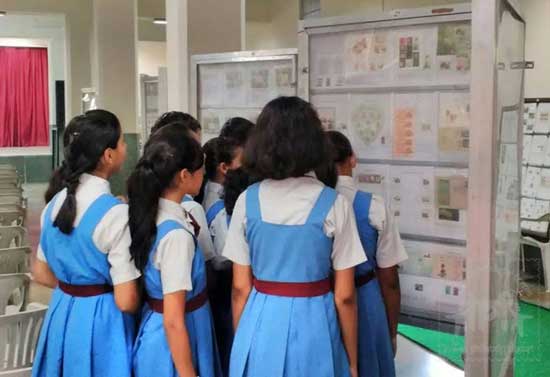
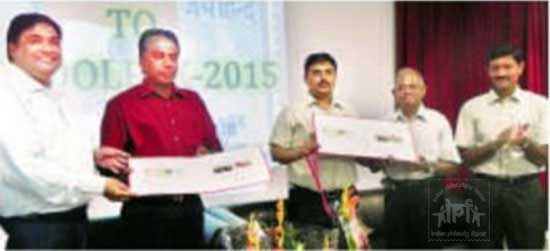


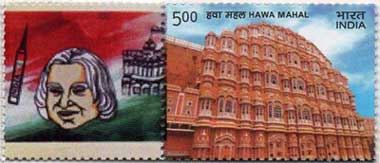
Courtesy: Rajesh Paharia, Jaipur
Commemorative Stamps on Charkha – 15th October 2015.
The Charkha or spinning wheel is a device for spinning thread or yarn from natural or synthetic fibres. Spinning wheels appeared in Asia, probably in the 11th century, and very gradually replaced hand spinning with spindle and distaff. The earliest clear illustrations of the spinning wheel come from Baghdad (drawn in 1234), China (c. 1270) and Europe (c. 1280), and there is evidence that spinning wheels had already come into use in both China and the Islamic world during the eleventh century.
 The charkha, or spinning wheel, was the physical embodiment and symbol of Gandhi’s constructive program. It represents Swadeshi, self-sufficiency, and at the same time interdependence, because the wheel is at the center of a network of cotton growers, carders, weavers, distributors, and users. It also embodied the dignity of labor, equality, unity, as all volunteers were to spin each day, and finally independence, as British control of India was rooted in control of indigenous industries such as textiles. The tabletop or floor charkha is one of the oldest known forms of the spinning wheel. The charkha works similarly to the great wheel, with a drive wheel being turned by hand, while the yarn is spun off the tip of the spindle. The floor charkha and the great wheel closely resemble each other. With both, the spinning must stop in order to wind the yarn onto the spindle.
The charkha, or spinning wheel, was the physical embodiment and symbol of Gandhi’s constructive program. It represents Swadeshi, self-sufficiency, and at the same time interdependence, because the wheel is at the center of a network of cotton growers, carders, weavers, distributors, and users. It also embodied the dignity of labor, equality, unity, as all volunteers were to spin each day, and finally independence, as British control of India was rooted in control of indigenous industries such as textiles. The tabletop or floor charkha is one of the oldest known forms of the spinning wheel. The charkha works similarly to the great wheel, with a drive wheel being turned by hand, while the yarn is spun off the tip of the spindle. The floor charkha and the great wheel closely resemble each other. With both, the spinning must stop in order to wind the yarn onto the spindle.
 India Post issued two commemorative stamps in denomination of Rs. 5 each and a Miniature Sheet on two popular types of Charkha, Peti charkha and Bardoli charkha on 15th October 2015.
India Post issued two commemorative stamps in denomination of Rs. 5 each and a Miniature Sheet on two popular types of Charkha, Peti charkha and Bardoli charkha on 15th October 2015.
Peti charkha is an efficient, portable and foldable spinning wheel. Since the traditional charkha was bulky and difficult to move, Mahatma Gandhi needed an instrument that could be transported easily. During his imprisonment in Yerwada jail, he had devised the portable spinning wheel that folds and has a handle for carrying. It is compact and folds into a wooden box. Bardoli charkha is a bigger size charkha in regular traditional form which one gets to see in many weavers house. Gandhiji often mentioned that his daily spinning was a form of meditation.

Special Cover on KSIC, Mysore Silk Centenary Celebrations – 15th October 2015.
Mysore is rich for its Royal heritage and Grandeur and it is no surprise that the silk produced there reflect the traditional splendor through its rich yet delicate motifs. The name Mysore silk is a befitting tribute to its ancestry. The silk weaving factory in Mysore, presently owned by KSIC, was established in the year 1912 by the Maharaja of Mysore province. Initially the silk fabrics were manufactured & supplied to meet the requirements of the royal family and ornamental fabrics to their armed forces. The unit was started with 10 looms and gradually increased to 44 looms over a period. The looms and preparatory machines were imported from Switzerland and was the first of its kind in India. After India gained Independence the Mysore state Sericulture Dept. took control of the silk weaving factory.
In 1980 the Silk weaving factory was handed over to Karnataka Silk Industries Corporation Ltd., a Govt. of Karnataka enterprise and is popularly known as KSIC. KSIC is the only organization in the country commanding the entire gamut of silk production right from reeling of cocoons to the weaving of pure silk fabric of various shades and designs, all under one roof. KSIC uses high quality pure natural silk and 100% pure gold zari. The zari never tarnish and will look fresh even over a long period of usage. KSIC is the only organization to give guarantee for its zari saree in the form of embroidered code No. which is unique to each saree.
To commemorate Centenary celebrations of KSIC, Mysore Silk a Special Cover was released at Bangalore on 15th October 2015 (Special Cover approval no. KTK/50/2015).

Cover Courtesy: Sushil Mehra, Bengaluru
Commemorative Stamp on Dr. APJ Abdul Kalam - 15th October 2015.
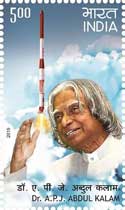 Avul Pakir Jainulabdeen "A. P. J." Abdul Kalam (b. 15 October 1931 – d. 27 July 2015) was the 11th President of India from 2002 to 2007. Kalam was born and raised in Rameswaram in Tamil Nadu, and studied physics and aerospace engineering. He spent the next four decades as a scientist and science administrator, mainly at the Defence Research and Development Organisation (DRDO) and Indian Space Research Organisation (ISRO) and was intimately involved in India's civilian space program and military missile development efforts. He thus came to be known as the Missile Man of India for his work on the development of ballistic missile and launch vehicle technology. He also played a pivotal organizational, technical, and political role in India's Pokhran-II nuclear tests in 1998, the first since the original nuclear test by India in 1974.
Avul Pakir Jainulabdeen "A. P. J." Abdul Kalam (b. 15 October 1931 – d. 27 July 2015) was the 11th President of India from 2002 to 2007. Kalam was born and raised in Rameswaram in Tamil Nadu, and studied physics and aerospace engineering. He spent the next four decades as a scientist and science administrator, mainly at the Defence Research and Development Organisation (DRDO) and Indian Space Research Organisation (ISRO) and was intimately involved in India's civilian space program and military missile development efforts. He thus came to be known as the Missile Man of India for his work on the development of ballistic missile and launch vehicle technology. He also played a pivotal organizational, technical, and political role in India's Pokhran-II nuclear tests in 1998, the first since the original nuclear test by India in 1974.
Kalam was elected as the 11th President of India in 2002. Widely referred to as the "People's President," he returned to his civilian life of education, writing and public service after a single term. He was a recipient of several prestigious awards, including the Bharat Ratna, India's highest civilian honour. While delivering a lecture at the Indian Institute of Management, Shillong, Kalam collapsed and died from an apparent cardiac arrest on 27 July 2015, aged 83.
The Prime Minister, Shri Narendra Modi released the commemorative stamp on the former President of India, Dr. A.P.J. Abdul Kalam, on his 84th birth anniversary celebrations, at DRDO Bhawan, in New Delhi on 15th October, 2015. The Union Ministers, Shri Manohar Parrikar, Shri M. Venkaiah Naidu, Shri Ravi Shankar Prasad and Dr. Harsh Vardhan were also present on the occasion.

Photo Courtesy: PIB
Special Cover on Golden Jubilee of Indira Gandhi Medical College, Shimla - 13th October 2015.
The present Indira Gandhi Medical College, Shimla, one of the premiers Institute of Country, was established in the year 1966 in the erstwhile Snowdon Hospital, Shimla with admissions of 50 students in the first batch. Its initial name was Himachal Pradesh Medical College, Shimla. The formal opening and foundation laying stone of the college was done by Smt. Sushila Nayar the then Union Health Minister on 13.10.1966. During the year 1978-79 its admission capacity was enhanced from 50 to 65 students. In 1984 it was re-named as Indira Gandhi Medical College, Shimla (now popularly known as IGMC in abbreviated form). The snowdon building housing Indira Gandhi Medical College, was earlier the official residence of Lord Kitchener, Commander in Chief of British Army in India. The college now also runs MD/MS courses in 20 disciplines alongwith DM/MCH courses in cardiology and Cardiac - thoracic Surgery, it has so far produced 2704 MBBS Graduates 923 Post Graduates and 377 Diploma students. The college is the biggest health institution in the State. Indira Gandhi Medical College, Shimla has also been granted the status of Regional Cancer Center by the Govt. of India, thus providing much needed comprehensive cancer care to the cancer patient.
On the occasion of Golden Jubilee Celebrations of Indira Gandhi Medical College, Shimla a Special Cover was released by Himachal Pradesh Chief Minister Shri Virbhadra Singh in presence of Chief Post Master General, Himachal Pradesh Postal Circle, Major General A.K. Shori at Shimla on 13th October 2015 (Special Cover approval No. HP/04/2015).
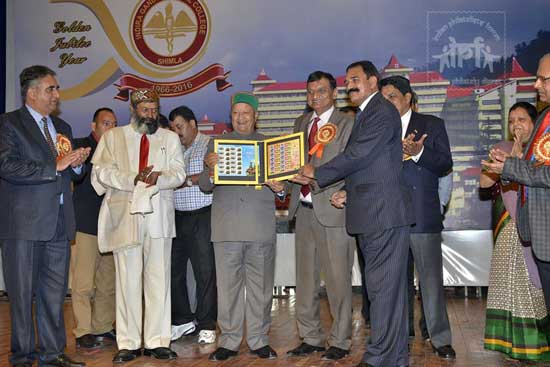
Courtesy: Sreejesh Krishnan, Thiruvananthapuram
Special Cover on Tabo Monastery, Lahaul and Spiti - 11th October 2015.
Tabo Monastery or Tabo Chos-Khor Monastery is situated in the Spiti valley above Tabo village on the left bank of the Spiti River in Himachal Pradesh. Tabo is 163 km from Kalpa and at a height of 3050 m. Tabo Monastery was founded in 996 CE in the Tibetan year of the Fire Ape by the Tibetan Buddhist lotswa (translator), Rinchen Zangpo (Mahauru Ramabhadra), the king of western Himalayan Kingdom of Guge. Tabo is noted for being the oldest continuously operating Buddhist enclave in both India and the Himalayas. A large number of frescoes displayed on its walls depict tales from the Buddhist pantheon. There are many priceless collections of thankas (scroll paintings), manuscripts, well-preserved statues, frescos and extensive murals which cover almost every wall. The monastery is in need of refurbishing as the wooden structures are aging and the thanka scroll paintings are fading. After the earthquake of 1975, the monastery was rebuilt, and in 1983 a new Du-kang or Assembly Hall was constructed. It is here that the 14th Dalai Lama held the Kalachakra ceremonies in 1983 and 1996. The monastery is protected by the Archaeological Survey of India (ASI) as a national historic treasure of India.
A Special Cover was released on Tabo Monastery at Tabo on 11th October 2015 (Special Cover approval no. HP/03/2015).
Courtesy: Sreejesh Krishnan, Thiruvananthapuram
Special Cover on Centenary of St. Edmund’s School, Shillong – 13th October 2015.
St. Edmund's School was established by the Congregation of Christian Brothers (India province) in Laitumkhrah, Shillong the capital of Meghalaya State in 1916. As early as 1894, Mgr. Edmund Becker, the prefect Apostolic of Assam had conceived the idea of a boarding school for boys in Shillong. St. Edmund’s School was officially opened on 6th October 1916 by Sir Archdale Earle. Br. Andrew Luke Aherne became the first Principal. In acknowledgement of Mgr. Edmund Becker’s immense contribution, St. Edmund’s School was named after his patron saint. It is an all-boys institution of the Roman Catholic Church affiliated to the Council for the Indian School Certificate Examinations, (ICSE) New Delhi.
To mark the Centenary of St. Edmund's School a Special Cover was released at Shillong GPO during the National Postal Week on the Philately Day, 13th October 2015. (Special Cover approval no. NE/02/2015-2016). Special Cancellation provided on the special cover is on National Postal Week and Philately Day.
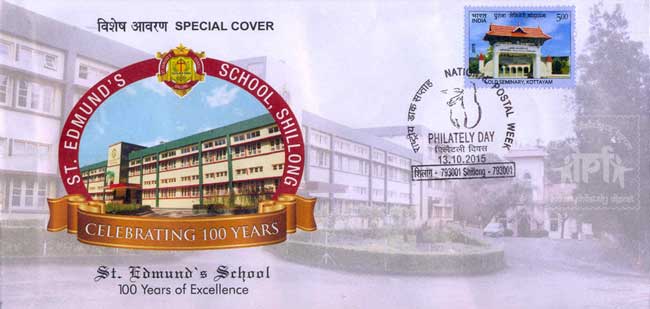
Cover Courtesy: Joy Justin Bongcher, Shillong
Special Cover on 75 years of State Training Centre, Umtyngar - 13th October 2015.
The Bharat Scouts and Guides in Meghalaya started at the first meeting held on 19-8-1972 under the Chairmanship of the then Education Minister Shri D.D. Pugh, when the state became full-fledged, along with some enthusiastic who stress the importance of starting the Movement in our state. The office started in November, 1972 in the office chamber of the then Inspector of Schools at Mawkhar, Shillong. Since then, the Association has been functioning very well under the Education Department. It has made tremendous progress in quality as well as in quantity.
The State Training Centre at Umtyngar about 22 kms from Shillong on Cherrapunjee Road is spread in about 3 acres of land. The Centre has a very old hall, a store-room, a kitchen and Choukidar's quarters. The Centre can accommodate about 800 boys and girls at a time in tents. The Meghalaya Bharat Scouts and Guides (MBSG) recently celebrated the Platinum Jubilee of the State Training Centre, Umtyngar.
To commemorate 75 years of State Training Centre, Umtyngar of Meghalaya Bharat Scouts & Guides a Special Cover was released at Shillong GPO during the National Postal Week on the Philately Day, 13th October 2015. Special Cancellation provided on the special cover is on National Postal Week and Philately Day.
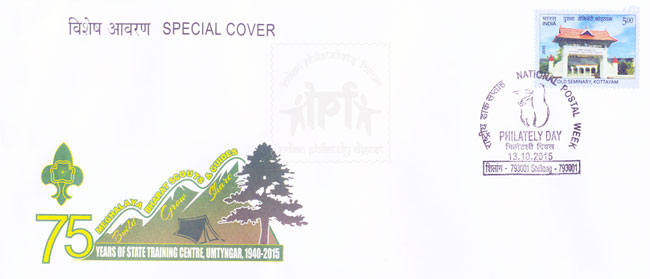
Cover Courtesy: Joy Justin Bongcher, Shillong
Philatelic exhibition at Imphal – 13th October 2015.
A philately exhibition was organised in the auditorium of CRPF Group Centre, Langjing, Imphal on 13th October 2015 on the occasion of Philately Day under National Postal Week celebrations in Manipur. Exhibition was inaugurated by DIG Shri Vikram Sahgal. Shri Vinod Kumar, Director (Posts) Manipur was present at the inauguration function. Letter writing competition was also held among the children of Kendriya Vidyalaya-2, Langjing. "My Stamp" facility was also made available during the exhibition.
Source: E-Pao.net
Special Cover on 100 Years of return of Mahatma Gandhi from South Africa to India - 13th October 2015.
Mahatma Gandhi arrived in South Africa at a young age of 24 years as the legal counsel of Indian traders based in the city of Pretoria. He spent more than two decades in South Africa, where he developed the concept of Satyagraha while fighting against the gross injustice, discrimination and racism prevailing there. Gandhiji returned to India in 1915 with a formidable reputation to lead the Indian masses struggling for freedom from colonial domination through civil disobedience and non-violence, which proved to be highly effective moral weapon in the India’s struggle for Independence.
A Special Cover was released to commemorate 100 Years of return of Mahatma Gandhi from South Africa to India on 13th October 2015 by Shri Vivek Kumar Daksh, Director Postal Services, Lucknow on the occasion of Ahimsapex-2015 philatelic exhibition organised by Lucknow Philatelic Society and India Post at GPO, Lucknow.


Courtesy: Sandeep Chaurasia, Gorakhpur
Daker Saaj - Stamp Exhibition 2015, West Bengal State Level Philatelic Exhibition - 8th – 13th October 2015.
Daker Saaj - Stamp Exhibition 2015, 8th West Bengal State Level Philatelic Exhibition was inaugurated by His Excellency Governor of West Bengal, Shri Keshari Nath Tripathi on 8th October, 2015 at Academy of Fine Arts, Kolkata in the presence of noted actress, director and playwright Ms. Saoli Mitra, Ms. Arundhaty Ghosh, Chief Postmaster General, West Bengal Circle, Shri P. K. Bisoi (Director, RAKNPA and Chairman of Jury team) and Shri Ashok Kumar Bayanwala, Jury Member. 280 Frames were on display consisting of 233 frames in senior class, 44 frames in youth class and 3 frames in school collection. Exhibits in 82 frames were displayed in invitee class. During the exhibition 5 Special Covers were released.
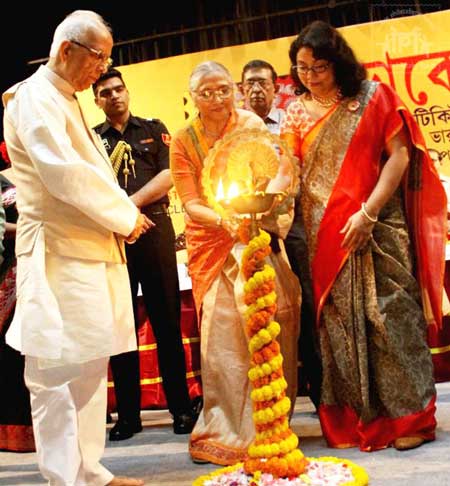
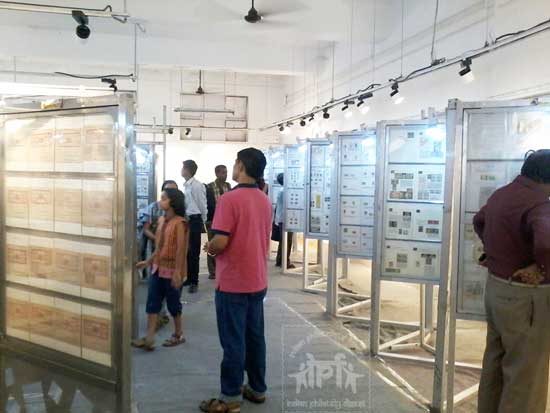
Special Cover on Sombhu Mitra – 8th October 2015.
Sombhu Mitra (b. 22 August 1915 - d. 19 May 1997) was a legendary Indian film and stage actor, director, playwright, reciter and an Indian theatre personality, known especially for his involvement in Bengali theatre, where he is considered a pioneer. He remained associated with the Indian People's Theatre Association (IPTA) for a few years before founding the Bohurupee theatre group in Kolkata in 1948. He is most noted for films like Dharti Ke Lal (1946), Jagte Raho (1956), and his production of Rakta Karabi based on Rabindranath Tagore's play in 1954 and Chand Baniker Pala, his most noted play as a playwright.
In 1966, the Sangeet Natak Akademi awarded him with its highest award, the Sangeet Natak Akademi Fellowship for lifetime contribution, then in 1970, he was awarded the Padma Bhushan, India's third highest civilian honour and in 1976 the Ramon Magsaysay Award.
A Special Cover was released on Sombhu Mitra by Hon. Governor of West Bengal Shri Keshari Nath Tripathi on the inaugural day of the exhibition in presence of Chief Post Master General, West Bengal Circle Ms. Arundhati Ghosh at Academy of Fine Arts in Kolkata on 8th October, 2015 (Special Cover approval no. WB/10/2015)

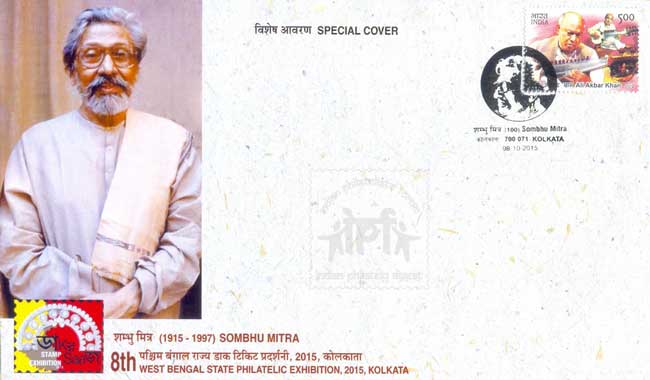
Special Cover on Adi Shakti Mahamaya Sri Jeen Mataji's Siddhpith - 9th October 2015.
Jeen Mata (Goddess of power) temple is located in Aravalli hills, Raiwasa in Sikar district of Rajasthan, 115km from Jaipur. Jeen Mata is an incarnation of the Durga. Jeen Mata place is known as Shakti Peeth and its full and real name was Jayantimala. The sacred shrine of Jeen Mata is believed to be a thousand years old. The year of its construction is not known, it is believed that Pandavas during their exile from Hastinapur reconstructed the temple in the present style. The temple of Jeenmata was a place of pilgrimage from early times and was repaired and rebuilt several times. A natural grace of serenity is lent by the lushgreen vegetation and rich flora, fauna around the temple. A large number of Jeen Mata's followers reside in Kolkata who keep visiting Jeen Mata temple.
A Special Cover on Adi Shakti Mahamaya Sri Jeen Mataji's Siddhpith was released on 9th October 2015.
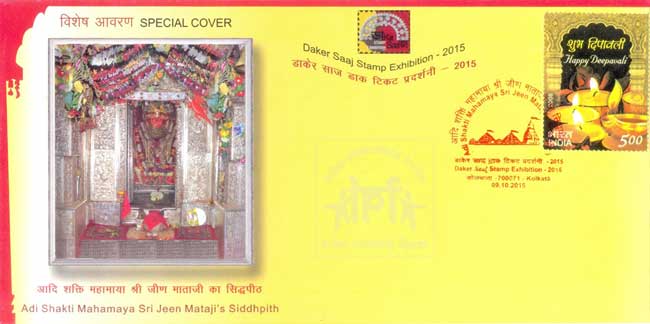
Special Cover on Lions Club of North Calcutta - 10th October 2015.
Lions Club of North Calcutta was founded on 2nd November 1961 by 34 people of the prestigious society of Calcutta who decided to join together to uphold a platform to mitigate the sufferings of the needy, the noblest of its kind. Lions North Calcutta Hospital & Medical Centre, Lions Safari Park and Vocational Training Centre are the epitome of services of Lions Club of North Calcutta. Lions North Calcutta Hospital is a medical service aider and provider empowering the needy with the best doctors and supporting medical team truly dedicated to our cause and mission, to abolish their pain. The Lions Safari Park is a one of its kind, ensuring the preservation of green environment in the busy concretized metropolitan of Calcutta. Our vocational Training Centre in north Calcutta revolves all around the major task of empowering the youth through self-employment training providing them with self confidence and self reliance, thus turning the wheels of a major social upliftment.
A Special Cover on Lions Club of North Calcutta was released on 10th October 2015.
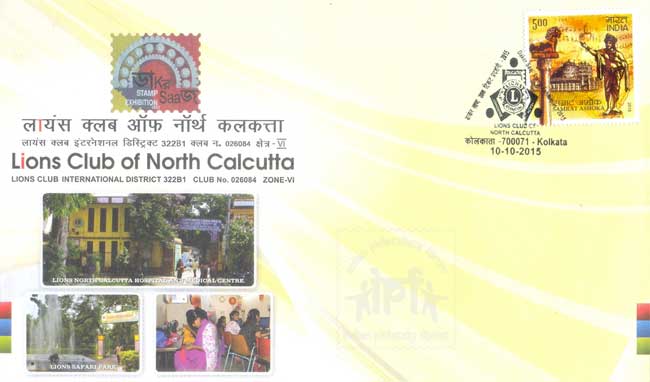
Special Cover on Centenary of First Meeting of Tagore with Gandhiji – 11th October 2015.
Rabindranath Tagore and Mohandas Karamchand Gandhi, two great Indians of the late Nineteenth and early Twentieth century had between them a kinship and appreciation of deepest character. They both were for Indianism, humanism and emancipation of dispossessed. An Englishman, Charles Freer Andrews, was the link between these two men. Tagore was the first notable contemporary to refer to Gandhi as Mahatma. Gandhiji also called him Gurudev, a term of respect by which many others called the poet. Even before the two actually met, a mutual regard existed between them. When Gandhiji returned from South Africa, it was Andrews who suggested that Tagore extend his invitation to the members of Gandhiji's "Phoenix family" (inmates of his Phoenix Ashram in South Africa), and arranged their temporary lodging in Santiniketan. Tagore and Gandhi met for the first time in March 1915 at Santiniketan.
A Special Cover was released to mark Centenary of First Meeting of Tagore with Gandhiji on 11th October 2015.
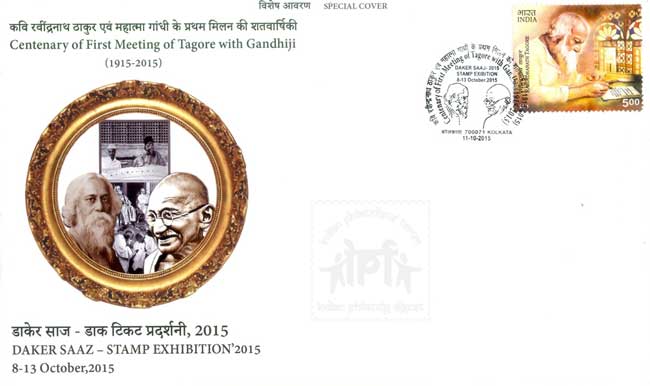
Special Cover on 81 Years of Establishment of All India Village Industries Association – 12th October 2015.
In 1934 Gandhiji resigned from the Indian National Congress over his differences with other leaders on the purity of ends and means. He established the "All India Village Industries Association" on 14th December 1934 in the upper room of Mahila Ashram at Wardha and devoted most of his time towards reorganization of Indian villages. Gandhiji started experiments in rural life-style such as revival of village crafts and agro processing industries, village cleanliness, and diet reforms, etc., so that villages could be developed as ideal surroundings to live in. He trained many workers in rural reconstruction work such as making Neera from palm trees, jaggery, leather work, pottery, oil pressing, bee - keeping etc.
To commemorate 81 Years of Establishment of All India Village Industries Association a Special Cover was released on 12th October 2015 at Daker Saaj philatelic exhibition (Special Cover approval no. WB/14/2015).
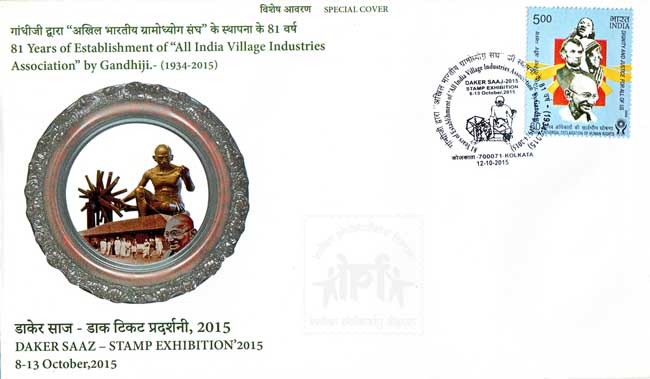
Six stamp booklets were released on 1. Mahatma Gandhi, 2. Nabakalebara 2015, 3. International Day of Yoga, 4. Samrat Ashoka, 5. Women Empowerment and 6. FIFA World Cup 2014 during the exhibition.
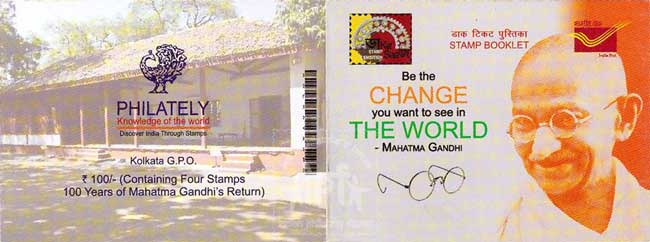
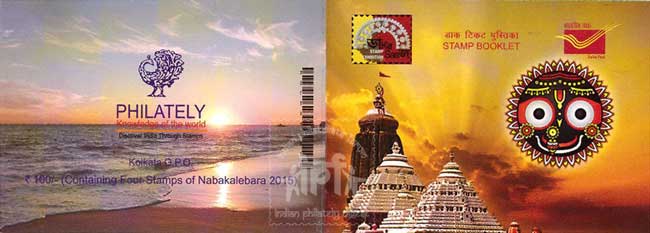
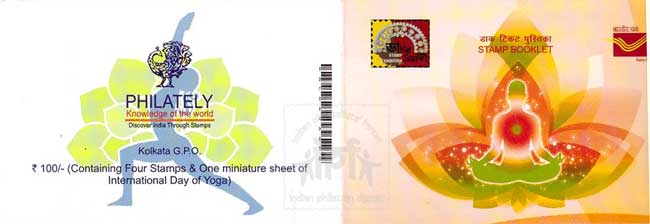
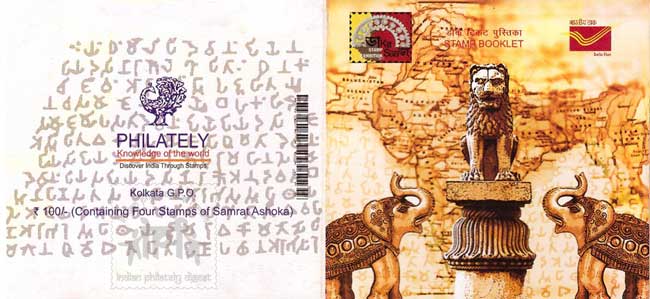
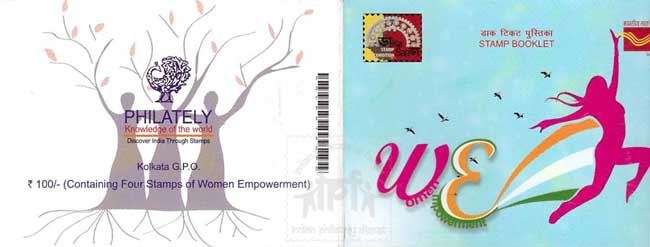
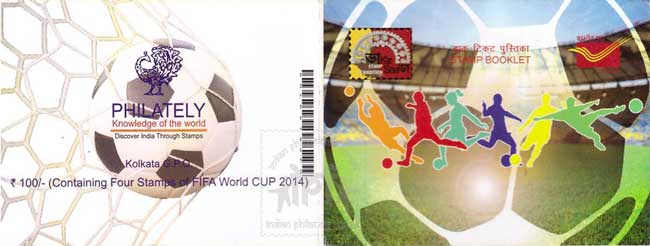
Six Gold, twenty Silver and eighteen Bronze medals were awarded by the jury team. In One Frame Exhibits first, second and third prizes were awarded.
Daker Saaj - Stamp Exhibition 2015 - Award List
Courtesy: Soumyajit Kundu, Kolkata | Ashok Kumar Bayanwala, Ahmedabad | prokerala.com
Special Cover on Silver Jubilee of Post Forum - 9th October 2015.
Post Forum was created way back in 1990 to bridge the gap between the postal department and the general public. The forum initially only had officials from the postal department as members. Later on, regular customers were also inducted as members. The Forum consists of members of eminent persons representing all walks of life, to foster better relations with the customers and to create ready responsiveness to the public needs. The Forum consists of seven members from trade, commerce, industry, bulk-mailers, social workers, prominent citizens and representatives from educational institutions and service organizations. The members of the Forum are nominated by the Postmaster General and have tenure of one year.
To mark the Silver Jubilee of the Post Forum a Special Cover was released by Dr. Charles Lobo, Chief Postmaster General, Tamil Nadu Circle, in the presence of eminent members of the Post Forum at the Philatelic Exhibition Hall, Anna Road HPO Complex, Anna Salai, Chennai on 9th October, 2015 on the occasion of World Post Day.
Special Cover having same design and cancellation were also released on 9th October 2015 at Tiruchirapalli, Madurai and Coimbatore. At Tiruchirapalli the cover was released by Shri Suvendu Swain, Postmaster General, Central Region (Special Cover approval nos. Chennai: TN/30/2015, Tiruchirapalli: TN/33/2015, Madurai: TN/32/2015 and Coimbatore: TN/31/2015).
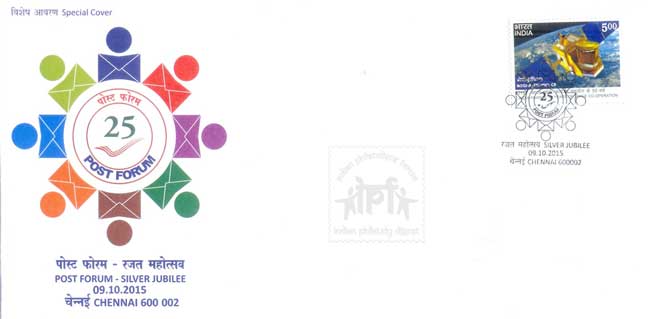
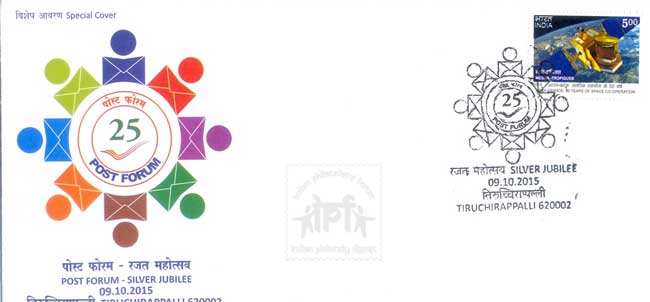
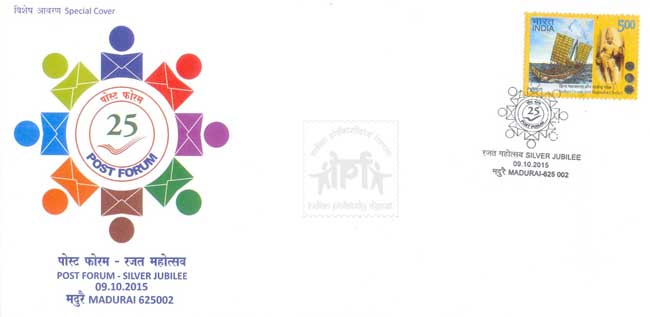

Cover Courtesy: Sreejesh Krishnan, Thiruvananthapuram
Special Cover on Digital India Post – 9th October 2015.
World Post Day is celebrated each year on 9th October, to commemorate the establishment of the Universal Postal Union (UPU) in 1874 in the Swiss capital, Berne. It was declared as World Post Day by the UPU Congress held in Tokyo, Japan, in 1969 and since then, it is celebrated all over the world to highlight the importance of the postal services.
India Post is celebrating National Postal Week from 9th to 15th October, 2014. The purpose of World Post Day is to create awareness about the role of the postal sector in the lives of people and business and its contribution to the social and economic development of the country. Department of Posts has actively entered into the digital era through counter mechanization and an IT modernization project that aims to connect all post offices across the country and this year the theme of celebration of World Post Day and National Postal Week is Digital India Post.
On the occasion of World Post Day a Special Cover on ‘Digital India Post’ was released at Mumbai on 9th October 2015.

Image Courtesy: Jigar Desai, Mumbai
KNLPEX-2015, Karnal District Level Philatelic Exhibition - 8th - 9th October 2015.
KNLPEX-2015, a district level philatelic exhibition was organised by the Karnal Postal Division on 8th and 9th October 2015 at Shri Krishna Mandir, Sector 14, Karnal. Two Special Covers were released during the exhibition.
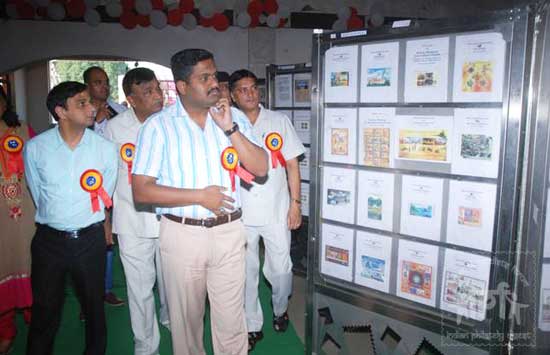
Special Cover on ‘Raahgiri Karnal’ - 8th October 2015.
‘Raahgiri Karnal’ campaign is initiated by the Haryana Police from 30th August 2015. It gives an opportunity to people to come together to stay fit and indulge in walking and cycling. A Special Cover on ‘Raahgiri Karnal’ campaign was released jointly by Shri Rajbir Deswal, Joint Director of Haryana Police Academy, Madhuban, Col Sukhdev Raj, Chief Postmaster General, Haryana Circle and Shri Jagdeep Gupta Director Postal Services, Haryana Circle.
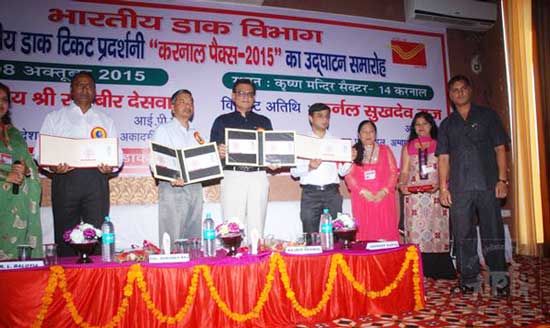
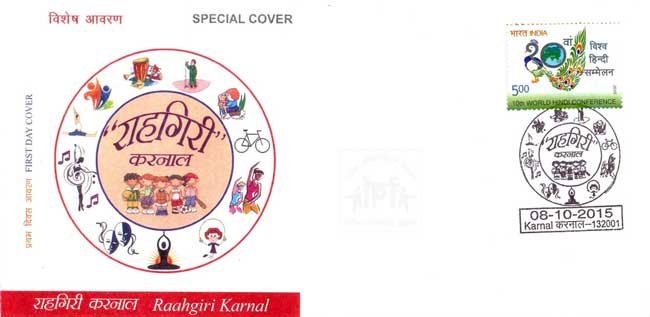
Special Cover on Smart City Karnal – 9th October 2015.
Karnal or the Rice Bowl of India is a city located in the NCR (National Capital Region) and the headquarters of Karnal District of Haryana. Karnal was also known as Karnaal, Kurnaul or Karnaul during the British Raj. Karnal is said to have been founded by Karna, a key figure in the epic Mahabharata, who died at the hands of his brother and archrival, Arjuna. The city is growing at a great pace towards development and information sector making it an important magnet for the state of Haryana. Karnal has been selected as one of the Smart Cities under the Ministry of Urban Development (MoUD), Smart City Mission. A Special Cover on Smart City, Karnal was released by Dr. J. Ganeshan, Deputy Commissioner Karnal and Shri Jagdeep Gupta Director Postal Services, Haryana Circle.
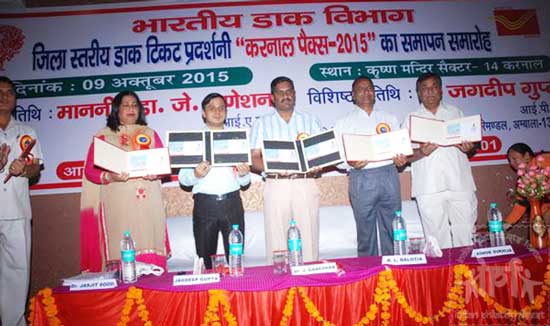
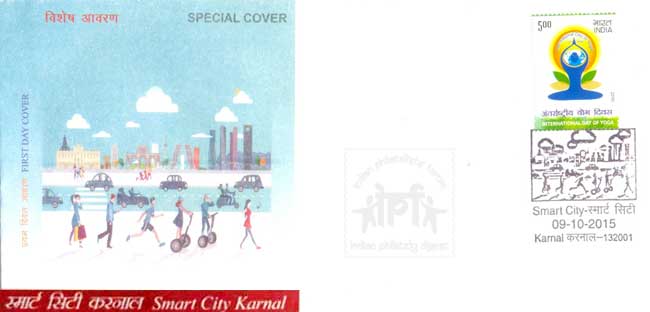
Photo Courtesy: CPMG Haryana Facebook Page
Special Cover on Asian Mycological Congress 2015 – 7th October 2015.
The Asian Mycological Congress is a major biennial event that brings together mycologists from all over Asia and fosters learning, dissemination and promotion of mycology. AMC 2015 will cover advances in all aspects of mycology. The Congress was held under the aegis of the Asian Mycological Association and the Mycological Society of India and organized by the Goa University from 7th to 10th October 2015.
Over 250 delegates attended the Asian Mycological Congress 2015 and of which 67 were from various Asian countries such as Japan, Korea, Malaysia, Nepal, Philippines, Singapore, Indonesia, Iran and Viet Nam. More than 20 Japanese delegates, including several senior scientists and young researchers came to Goa and attended the AMC 2015. In addition, mycologists from UK, USA, Canada, New Zealand and Germany participated and delivered lead lectures in the Congress.
A Special Cover was released to mark the occasion by Shri Laxmikant Parsekar, Chief Minister of Goa at the Goa University on 7th October 2015. On the occasion a philatelic exhibition on mycological species was presented by Dr. Bernard Rodrigues, Professor, Department of Botany, Goa University who is also an avid philatelist.
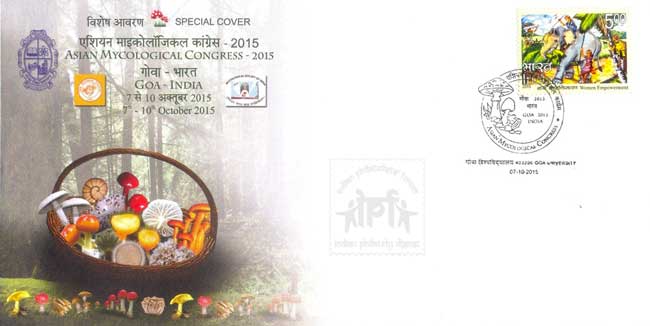
Courtesy: Kaushik Dessai, Goa | Leonard Fernandes, Goa
Personalised Stamp on 50th anniversary of Srila Prabhupada’s visit to Sri Lanka by Sri Lanka Post – 4th October 2015.
The Hare Krishna movement in Sri Lanka is active in Sri Lanka, especially in Kotahena (Colombo 13) due to the presence of a Hare Krishna Temple in this area. The 50th anniversary of spiritual leader Srila Prabhupada’s visit to Sri Lanka was celebrated by the devotees and congregation of ISKCON Sri Lanka on the 19th August 2015. Srila Prabhupada’s visited the island on 19th August, 1965.
To mark the 50th anniversary of Srila Prabhupada’s visit to Sri Lanka a personalised stamp and commemorative cover were released by Sri Lanka Post on 4th October 2015 at the function held at Ramakrishna Mission Hall, Wellawatta, Colombo - 06. The Honourable Deputy Minister of Posts of Sri Lanka Mr. Dulip Wijesekara released personalised stamp and handed over the commemorative covers with the stamps to the special invitees of the function.
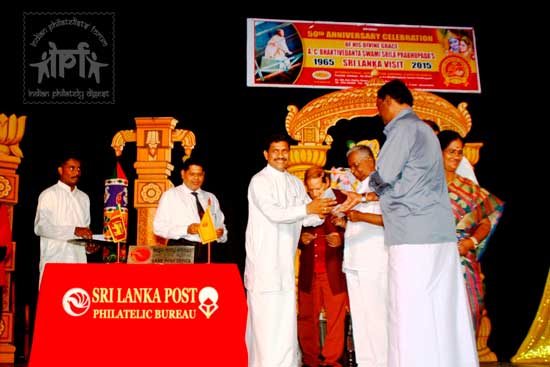
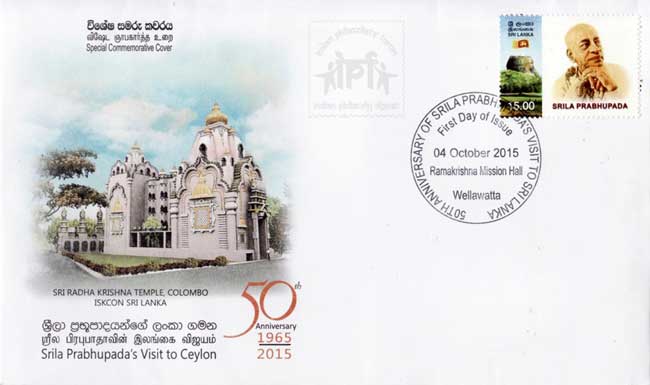
Cover Courtesy: Jayendra Pathmaperuma, Sri Lanka
Special Cover on Platinum Jubilee Celebration of 29 Field Ammunition Depot – 3rd October 2015.
29 Field Ammunition Depot located at Dehu Road, Pune completed 75 years of raising during September 2015 and the depot celebrated its Platinum Jubilee on 3rd October 2015. Ammunition Depot, Dehu Road is one of the biggest defence echelon located in Pune and is responsible to look after the requirement of ammunition for a large number of defence units located in southern India. The depot was raised during the World War II and has participated in all major military operations including 1965, 1971 war and operation Vijay and Operation Parakram.
A Special Cover was released by Lt Gen Amit Sarin, SM, VSM, to mark Platinum Jubilee Celebration of 29 Field Ammunition Depot, Dehu Road, Pune.
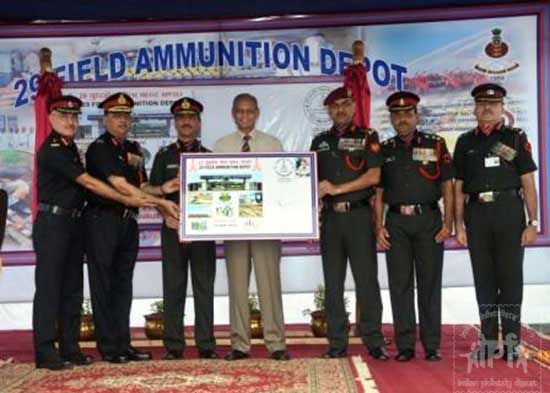
Source: Punekar News
Special Cover on Injury Prevention - 3rd October 2015.
The INDO-US Emergency and Trauma partnership involves the University of South Florida (USF), SUNY Downstate, Baroda Medical College-SSG Hospital and the All India Institute of Medical Sciences (AIIMS). It enjoys the whole hearted support of the World Association of Disaster and Emergency Medicine. This partnership came into existence in 2005 at New Delhi. Academic Leaders from US and India shared similar blueprints regarding the development of the academic fields of Trauma and Emergency care in India. To fulfill the vision Annual INDUSEM Summits (The INDO-US Emergency Medicine Academic Summits) are organized since 2005.
‘INDUSEM2015’, the 11th INDO-US World Congress of Emergency Medicine was organized at All India Institute of Medical Sciences, New Delhi from 30th September to 4th October 2015 at New Delhi. It was hosted by a coalition of Global Partners Lead by USF, SUNY, WADEM and AIIMS in cooperation with MCI Recognized Medical Colleges India.
On this occasion a Special Cover on ‘Injury Prevention’ was released by Shri Rajinder Kashyap, Postmaster General (Operations), Delhi Circle on 3rd October, 2015.
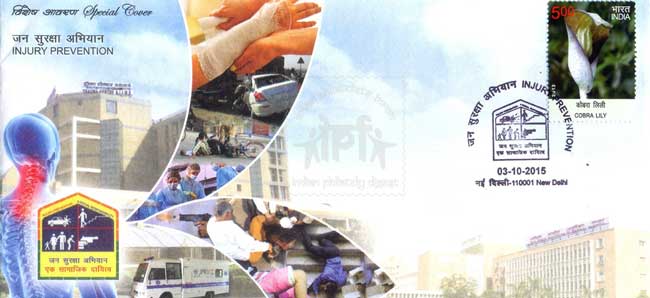
Image Courtesy: Sreejesh Krishnan, Thiruvananthapuram
Special Cover on Mission Devrai (Sacred Groves) – 3rd October 2015.
Sacred Groves (Devrai in Marathi) are virgin forests near the village, maintained and taken care of by locals of that village, dedicated to a local deity. There is no human intervention making these perfect ecological hotspots. No one is permitted to cut any tree or plant, kill animals or birds or harm any form of life in this area. It is well known that villagers around forest depend on the forest for their livelihood. When a certain area is identified as scared grove by villagers, they ensure that the area is not disturbed by them. Sacred Groves turns the area into a dense forest with rich bio-diversity, which remains untouched. Sacred groves are not only an Indian phenomenon.
Nature worship is an integral part of human society and the Sacred Groves, one form of nature worship, are considered as “Sacred Natural Sites” and have been preserved over generations in India. The concept of sacred groves in India has its roots in antiquity, even before the Vedic age. Historical references to sacred groves can be obtained from ancient classics as far back as Kalidasa's Vikramuurvashiiya. One can find them in Africa, or even native Indian communities in North American countries. Sacred groves did not enjoy protection by Government in India but the introduction of the protected area category community reserves under the Wild Life (Protection) Amendment Act, 2002 has introduced legislation for providing government protection to community held lands, which could include sacred groves. In the state of Maharashtra more than 3,500 Devrais, or the Sacred Groves are known. There are around 230 such sacred groves noted in Pune district. As faith and beliefs change these protected groves have started showing signs of deteriorations. The rapid urbanization is posing great threats to these community reserves.
To protect these sacred groves in Maharashtra, Maharashtra Vruksha Samvardhini has started a project called ‘Mission Devrai’ for documentation and conservation of these Devrais which are an important part of our heritage, cultural as well as ecological. To spread awareness about sacred groves a unique festival called ‘Devrai Jagruti Festival’ was organized by Maharashtra Vruksha Samvardhini and Nature Walk Charitable Trust from 1st to 4th October 2015 and as a part of festival an exhibition of Sacred Groves was organized at Bhandarkar Oriental Research Institute, Pune and an awareness program at S. M. Joshi Auditorium, Navi Peth, Pune on 3rd and 4th October 2015.
On the occasion a Special Cover was released on ‘Mission Devrai’ by Shri Ganesh Sawaleshwarkar, Postmaster General, Pune Region (Special Cover approval no. MH/28/2015) at the function held at S. M. Joshi Auditorium, Navi Peth, Pune on 3rd October 2015.


Stamp exhibition on Mahatma Gandhi at Salem – 2nd – 15th October 2015.
 To promote philately, and to honour Mahatma Gandhi on his 146th birth anniversary, a stamp exhibition on Mahatma Gandhi is organized by the Department of Posts at Gandhi Museum in Hasthampatti Post Office, Salem. Exhibition was inaugurated by the Deputy Mayor M. Natesan on 2nd October 2015. Ms. Manju P. Pillai, Postmaster General, Western Region, Tamil Nadu, and B. Arumugam, Senior Superintendent of Post Offices, Salem East Division, were present on the occasion. A philatelic counter and facility of ‘My Stamp’ are also available at the exhibition.
To promote philately, and to honour Mahatma Gandhi on his 146th birth anniversary, a stamp exhibition on Mahatma Gandhi is organized by the Department of Posts at Gandhi Museum in Hasthampatti Post Office, Salem. Exhibition was inaugurated by the Deputy Mayor M. Natesan on 2nd October 2015. Ms. Manju P. Pillai, Postmaster General, Western Region, Tamil Nadu, and B. Arumugam, Senior Superintendent of Post Offices, Salem East Division, were present on the occasion. A philatelic counter and facility of ‘My Stamp’ are also available at the exhibition.
Source: The Hindu
Special Cover on Dharmashala Cricket Stadium – 2nd October 2015.
Himachal Pradesh Cricket Association Stadium or HPCA Stadium is located in the city of Dharamshala in Himachal Pradesh. The town is best known internationally as the home of the Dalai Lama of Tibet. The Stadium provides all the modern day facilities prevalent in other International venues across the world. It has a seating capacity of about 23000 spectators with the requisite facilities, latest irrigation facilities, well equipped gymnasium, separate press gallery, TV & Radio Commentators Boxes, club house, recreational centre, post match conference hall, and indeed one of the most picturesque views in the world. The stadium is home to Himachal Pradesh cricket team for Ranji Trophy matches and other limited overs matches. The stadium also hosted IPL matches as a home stadium for Kings XI Punjab. The first ODI was played between India and England in January 2013 and the second ODI was played between India and West Indies on 17th October 2014.
On the occasion of India Vs South Africa first T20 match at Dharamshala Stadium a Special Cover was released at Dharamshala on 2nd October 2015 (Special Cover approval no. HP/05/2015).

Special Cover on Diamond Jubilee of Integral Coach Factory – 2nd October 2015.
Integral Coach Factory (ICF), Chennai, is a premier Production Unit of Indian Railways manufacturing railway passenger coaches. ICF is the first of its kind to be established after Independence for the manufacture of light weight, all steel and all welded Integral railway passenger coaches. The factory was set up in 1955 with Swiss collaboration. ICF’s initial plan was to produce 350 Broad Gauge Third Class shells (unfurnished body of the Railway Coaches) only, which were to be furnished by the Zonal Railways’ workshops. Later, in view of the severe limitation of capacity of the Railway workshops and also to take advantage of mass production, a separate Furnishing Division was added on 2nd October, 1962. So far ICF has obtained the ISO: 9001, ISO: 1400, ISO: 18001 and Golden Peacock Eco-Innovation Award-2012 certificates for the QMS, EMS and OHSAS systems.
As part of Diamond Jubilee Celebrations a Special Cover was released on Integral Coach Factory at the Valedictory function of the Diamond Jubilee Celebrations of ICF held at the Dr. Ambedkar Arangam, ICF on 2nd October 2015. Shri Manoj Sinha, Hon’ble Minister of State for Railways and Shri Charles Lobo, Chief Postmaster General, Tamilnadu Postal Circle released the special cover.


Alwarpex-2015, 4th District Level Philatelic Exhibition at Alwar - 30th Sept. - 2nd October 2015.
Alwarpex-2015, 4th Alwar District level philatelic exhibition was organized by Alwar Postal Division at Adinath Public School, Scheme no. 8, Alwar from 30th September to 2nd October 2015. Exhibition was inaugurated by Shri Muktanand Agarwal, Dist. Collector, Alwar and Lt. Col. D. K. S. Chauhan, Chief Postmaster General, Rajasthan Circle on 30th September 2015. During the exhibition two special covers were released.
Special Cover on Moosi Maharani Ki Chhatri, Alwar - 30th September 2015.
Moosi Maharani ki Chhatri is a beautiful red sandstone and white marble cenotaph is on the banks of Sagar a beautiful lake dedicated to Bakhtawar Singh mistress who performed sati here. The centopath reflects Indo-Islamic style of architecture. The upper portion is in marble with columned pavilions and domed arches with exquisite floral tracery rests over the pillared red sand stone story. A Special Cover on Moosi Maharani Ki Chhatri, Alwar was released on 30th September 2015.
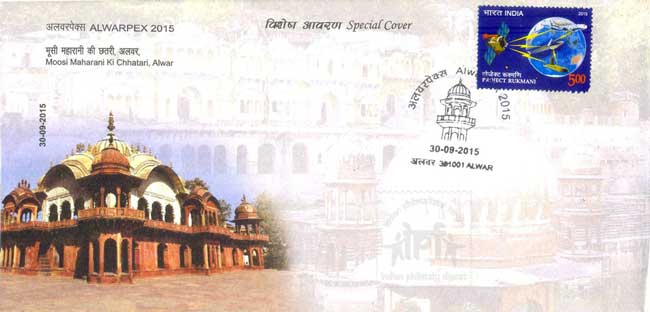
Special Cover on Sukanya Samriddhi Scheme - 2nd October 2015.
Sukanya Samriddhi Account is a scheme launched by the Government of India which is a part of its “Beti Bachao - Beti Padhao” initiative and was launched on 22nd January 2015. It is a small savings scheme, which can be opened by the parents or a legal guardian of a girl child in any post office or authorized branches of some of the commercial banks. Parents or a legal guardian can open an account in the name of a girl child right from the birth of a girl child till she attains the age of ten years. A Special Cover on Sukanya Samriddhi Scheme was released on 2nd October 2015.
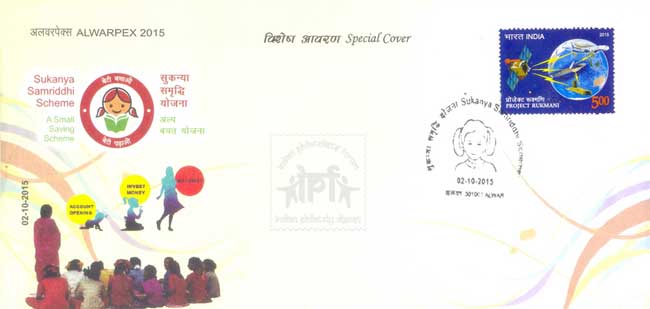
Cover Courtesy: Sreejesh Krishnan, Thiruvananthapuram
Commemorative Stamp on Mahant Avaidyanath – 1st October 2015.
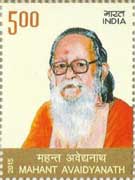 Mahant Avaidyanath (b.28 May 1921 – d. 12 September 2014) was a spiritual leader and politician. Mahant Avaidyanath was born on 18th May 1919 in Kandi in Garhwal district of Uttarakhand. His childhood name was Kripal Singh.. As a child Kripal Singh was drawn towards achieving salvation from this world. He got patronage of saints in Rishikesh and Haridwar. His inclination towards Nathpanth (cult) came after his association with Yogi Nirvrittinath, a saint of Nathpanth. Kripal Singh visited the Gorakhnath temple in Gorakhpur with yogi Nirvrittinath in the year 1940. He became Mahant of Gorakhnath temple on 8th February 1942. Mahant Digvijaynath ji Maharaj gave Kripal Singh the name 'Avaidyanath'.
Mahant Avaidyanath (b.28 May 1921 – d. 12 September 2014) was a spiritual leader and politician. Mahant Avaidyanath was born on 18th May 1919 in Kandi in Garhwal district of Uttarakhand. His childhood name was Kripal Singh.. As a child Kripal Singh was drawn towards achieving salvation from this world. He got patronage of saints in Rishikesh and Haridwar. His inclination towards Nathpanth (cult) came after his association with Yogi Nirvrittinath, a saint of Nathpanth. Kripal Singh visited the Gorakhnath temple in Gorakhpur with yogi Nirvrittinath in the year 1940. He became Mahant of Gorakhnath temple on 8th February 1942. Mahant Digvijaynath ji Maharaj gave Kripal Singh the name 'Avaidyanath'.
Mahant Avaidyanath was elected MLA from Maniram Assembly segment five times – 1962, 1967, 1969, 1974 and 1977. He was elected Lok Sabha member from Gorakhpur as an Independent candidate in 1970 and won again in 1989 as candidate of Hindu Mahasabha. He was elected MP from the same seat in 1991 and 1996 as Bharatiya Janata Party nominee. He played an important role in Ram Janmabhoomi movement. He was the teacher and predecessor of Yogi Adityanath the present MP of Gorakhpur.
Communications & IT Minister Ravi Shankar Prasad released a commemorative stamp in denomination of Rs. 5 on 1st October 2015 at Gorakhpur to mark Avaidyanath’s first death anniversary. Shri Yogi Adityanath, M.P. of Gorakhpur and Smt. Sarita Singh, Chief Postmaster General, UP Circle were also present on the occasion.


Courtesy: Sandeep Chaurasia, Gorakhpur | Ashwani Kumar Dubey, Gorakhpur

